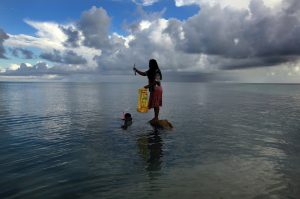While the Pacific is often used as the “poster-child” of climate change – complete with images of islands submerged by rising seas – the reality is more complex, though no less urgent. The relationship between climate change and the movement of people is particularly important. People in the Pacific, and indeed throughout the world, have always moved because of changes in their environment. But today the pressures are increasing as a result of long-term changes in climate, but also because of settlement patterns, population growth, and economic pressures. Rather than whole communities having to abandon their small island states because of surging waves, it is more likely that we will see more people moving via traditional economic migration routes. It will also likely be hard to tell if people are moving because of the effects of climate change or because they seek better economic prospects elsewhere. Most people will move within the borders of their countries, but particularly in the Pacific, there may be increasing population movements across borders.
The Pacific Islands comprises 22 countries and territories, with a combined population of 9.2 million. The region includes 7,500 islands, of which 300 are inhabited, and extends over a huge area, mostly sea, of 30 million square kilometers. The population of Pacific Island states ranges from 10,000 in Tuvalu to almost 7 million in Papua New Guinea. Nearly all of the Pacific Island countries fall under the UN’s category of Small Island Developing States, or “SIDS” as they are known in UN parlance.
The Pacific Islands, like all small island countries, have limited land and little economies. Remote from main shipping lines, they incur high external shipping costs. Many rely heavily on tourism. With large coastal zones, their ability to mitigate against the effects of disasters is limited.
Historically and culturally, Pacific populations have a deep attachment to their land and to the ocean; the prospect of having to leave their traditional lands and communities is a wrenching one, particularly when the pressures to move are coming from forces beyond their control. Although it is expected to suffer disproportionately from the effects of climate change, the Pacific region is responsible for only a tiny percentage of the world’s greenhouse gas emissions but is already feeling the effects. This raises questions of international responsibility and of justice.
The Pacific and Climate Change
Pacific Island leaders have often been on center stage of international discussions on climate change, passionately urging wealthy countries to reduce their emissions and to agree to stronger targets and protocols to reduce the effects of climate change (or at least to slow its pace). These are life and death issues for the Pacific Islands and for other small island states. Kiribati’s President Anote Tong underlined the urgency of actions to mitigate the effects of climate change for the Pacific and the world:
“…as an international community we cannot continue with business as usual, we must work together to respond and act with responsibility; we must listen, take heed of what is happening in these most vulnerable states in the frontline and act accordingly, act with urgency…what is happening in these frontline States concerns all of us… it must be taken as an early warning to the international community and a precursor for what could ultimately be the fate of humanity if further action is delayed.”

































